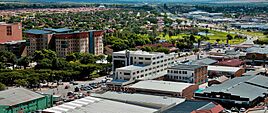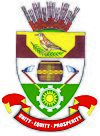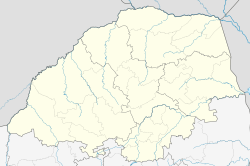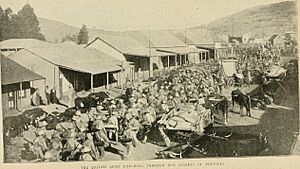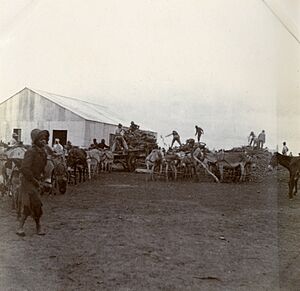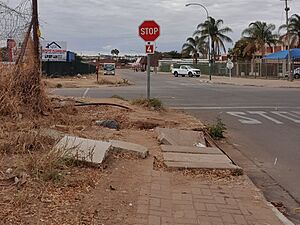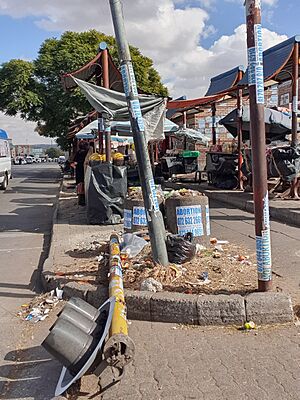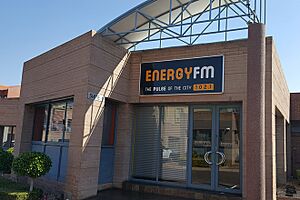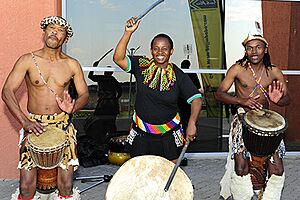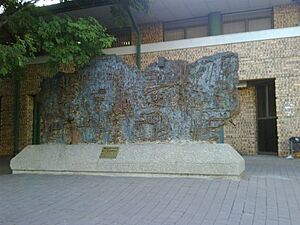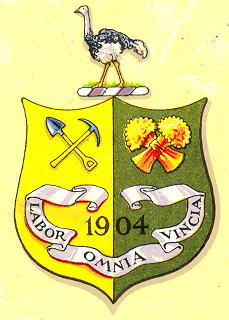Polokwane facts for kids
Quick facts for kids
Polokwane
Pietersburg
|
|||
|---|---|---|---|
|
City
|
|||
|
Part of the CBD
City Centre
|
|||
|
|||
| Nickname(s):
The City of Stars
|
|||
| Motto(s):
Unity - Equity - Progress - Prosperity
|
|||
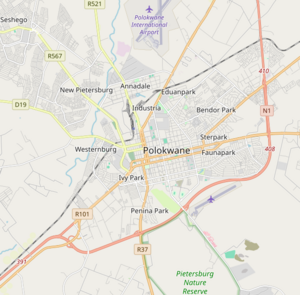 |
|||
| Country | |||
| Province | Limpopo | ||
| District | Capricorn | ||
| Municipality | Polokwane | ||
| Established | 1886 | ||
| Founded by | Voortrekkers | ||
| Named for | Petrus Jacobus Joubert | ||
| Government | |||
| • Type | Local Municipality | ||
| • Body | Polokwane Municipality | ||
| Area | |||
| • Total | 106.84 km2 (41.25 sq mi) | ||
| Elevation | 1,310 m (4,300 ft) | ||
| Population
(2011)
|
|||
| • Total | 130,028 | ||
| • Density | 1,217.03/km2 (3,152.11/sq mi) | ||
| Racial makeup (2011) | |||
| • Black African | 74.4% | ||
| • Coloured | 3.7% | ||
| • Indian/Asian | 3.1% | ||
| • White | 18.2% | ||
| • Other | 0.5% | ||
| First languages (2011) | |||
| • Sepedi | 45.9% | ||
| • Afrikaans | 19.8% | ||
| • English | 10.3% | ||
| • Venda | 6.7% | ||
| • Other | 17.3% | ||
| Time zone | UTC+2 (SAST) | ||
| Postal code (street) |
0699
|
||
| PO box |
0700
|
||
| Area code | 015 | ||
| Bird | Northern royal albatross | ||
| Flower | Blue squill | ||
Polokwane (which means "Sanctuary" in Northern Sotho), also known as Pietersburg, is the main city of the Limpopo Province in South Africa. It is the biggest city in South Africa north of Gauteng. Polokwane was one of the nine cities that hosted games for the 2010 FIFA World Cup.
Contents
- History of Polokwane
- City Challenges
- People of Polokwane
- Polokwane's Climate
- Getting Around Polokwane
- Culture and Community
- Sports in Polokwane
- Tourism and Nature
- Business and Economy
- Learning and Education
- Shopping Places
- Sister Cities
- Famous People from Polokwane
- City Symbols (Coats of Arms)
- Images for kids
- See also
History of Polokwane
Early Beginnings
In the 1840s, a group of settlers called Voortrekkers, led by Andries Hendrik Potgieter, started a town called Zoutpansbergdorp. This town was about 100 km north of where Polokwane is today. They had to leave this settlement because of fights with local tribes.
In 1886, they started a new town and named it "Pietersburg." This name honoured a Voortrekker leader named Petrus Jacobus Joubert. Before the 1900s, a small number of Indian/Asian and Coloured people also settled in the area.
During the Second Boer War (1899-1902), Pietersburg was the capital of the Transvaal and the Orange Free State for a short time in 1900. The British took control of Pietersburg in 1901. They built a concentration camp there, where nearly 4,000 Boer women and children were kept.
Life During Apartheid
Like many places in South Africa during the time of apartheid, the town had strict rules about racial separation and unfairness. After the Second Boer War and the creation of the Union of South Africa in 1910, laws were put in place to divide urban areas.
When apartheid officially started in 1948, Pietersburg became clearly separated for living and business. The Group Areas Act of 1950 and its changes in 1966 made sure that the main business area (CBD) was only for white people. Other parts of the CBD were set aside for other racial groups, like an "Indian centre" for Indian/Asian people.
Many areas were meant for only one specific race. For example, the suburbs of Nirvana and Westernburg were for Indian/Asian and Coloured groups. The suburb of Bendor was only for white people. The townships of Seshego and Mankweng were where the Black population lived. People from minority groups were often forced to move so white people could live there. Industries were owned only by white people, and there were strong barriers between people of different races.
Polokwane Since 1994
The town officially became a city on 23 April 1992. After the 1994 South African general elections on 27 April 1994, it became the capital of the new Northern Transvaal province. This province later changed its name to "Northern Province" and then to Limpopo.
On 25 February 2005, the government officially changed the city's name to Polokwane. This name was already commonly used by people who spoke Northern Sotho (Sepedi).
In December 2007, the city hosted the 52nd national conference of the African National Congress at the University of Limpopo. At this meeting, Jacob Zuma was chosen as the President of the ANC, beating the former president Thabo Mbeki.
Today, Polokwane has grown a lot. It has modern buildings, many shops and malls, restaurants, and places for entertainment. It also has different places of worship and new housing areas.
City Challenges
Even with all the new developments, Polokwane still faces problems with public services. Things like electricity, water, and sewage systems are often not available in many communities. Public structures like traffic lights, street lights, roads, and sidewalks also need a lot of work.
People of Polokwane
Population and Languages
In 2011, the city had about 130,000 people. About 45.9% of the people in Polokwane speak Sepedi (Northern Sotho). Many white residents are Afrikaners. About 10,000 residents (around 8%) are English-speaking white people, mostly South Africans of British descent and White Zimbabweans who moved there after 2000. About 6.7% of the people are Venda people.
| Population Group | Percentage |
|---|---|
| African | 74.4% |
| Coloured | 3.7% |
| Indian/Asian | 3.1% |
| White | 18.2% |
Neighbourhoods and Areas
Some of the neighbourhoods in Polokwane include Nirvana, Westenburg, Bendor, Welgelegen, Moregloed, Annadale, Ivydale, Flora Park, Fauna Park, Greenside, Penina Park, Ivy Park, Hospital Park, Ster Park, Dalmada, Broadlands, Woodlands, Southern Gateway and Thornhill.
There are also three groups of neighbourhoods outside the city centre:
- The Seshego group, located on the north-west edge of the city.
- The Molepo/Maja/Chuene group, about 20 km south of the city centre.
- The Mankweng/Sebayeng/Dikgale group, about 30 km east of the city centre.
Polokwane's Climate
Polokwane has a semiarid climate. Even though it is near the Tropic of Capricorn, its climate is milder because it sits on a plateau about 1230 metres above sea level.
Average temperatures are around 21-22°C in January and drop to about 11°C in July. Like much of inland South Africa, Polokwane has had warmer seasons in the last ten years than its usual average.
The city has a dry climate with a rainy season in summer. Winters are very dry. The average yearly rainfall is 495 mm. December or January are usually the wettest months, and July is the driest.

| Climate data for Polokwane (1991−2020, extremes 1953–present) | |||||||||||||
|---|---|---|---|---|---|---|---|---|---|---|---|---|---|
| Month | Jan | Feb | Mar | Apr | May | Jun | Jul | Aug | Sep | Oct | Nov | Dec | Year |
| Record high °C (°F) | 37.1 (98.8) |
38.4 (101.1) |
34.5 (94.1) |
33.9 (93.0) |
32.8 (91.0) |
28.6 (83.5) |
27.8 (82.0) |
32.0 (89.6) |
36.8 (98.2) |
37.0 (98.6) |
37.4 (99.3) |
36.8 (98.2) |
38.4 (101.1) |
| Mean daily maximum °C (°F) | 28.2 (82.8) |
28.4 (83.1) |
27.3 (81.1) |
25.3 (77.5) |
23.5 (74.3) |
21.1 (70.0) |
20.8 (69.4) |
23.4 (74.1) |
26.5 (79.7) |
27.3 (81.1) |
27.4 (81.3) |
27.8 (82.0) |
25.6 (78.1) |
| Daily mean °C (°F) | 22.7 (72.9) |
22.6 (72.7) |
21.4 (70.5) |
18.8 (65.8) |
15.8 (60.4) |
13.1 (55.6) |
12.7 (54.9) |
15.2 (59.4) |
18.6 (65.5) |
20.4 (68.7) |
21.3 (70.3) |
22.2 (72.0) |
18.7 (65.7) |
| Mean daily minimum °C (°F) | 17.1 (62.8) |
16.9 (62.4) |
15.5 (59.9) |
12.2 (54.0) |
8.2 (46.8) |
5.2 (41.4) |
4.6 (40.3) |
7.0 (44.6) |
10.6 (51.1) |
13.5 (56.3) |
15.2 (59.4) |
16.6 (61.9) |
11.9 (53.4) |
| Record low °C (°F) | 9.8 (49.6) |
10.6 (51.1) |
7.9 (46.2) |
3.6 (38.5) |
0.2 (32.4) |
−3.5 (25.7) |
−3.2 (26.2) |
−2.4 (27.7) |
0.2 (32.4) |
5.0 (41.0) |
6.9 (44.4) |
8.8 (47.8) |
−3.5 (25.7) |
| Average precipitation mm (inches) | 84.5 (3.33) |
65.8 (2.59) |
52.4 (2.06) |
30.7 (1.21) |
11.4 (0.45) |
2.6 (0.10) |
2.1 (0.08) |
1.6 (0.06) |
4.7 (0.19) |
37.2 (1.46) |
88.5 (3.48) |
93.2 (3.67) |
474.7 (18.69) |
| Average precipitation days (≥ 1.0 mm) | 7.0 | 5.5 | 5.3 | 3.1 | 1.3 | 0.6 | 0.4 | 0.2 | 0.8 | 3.8 | 7.3 | 7.9 | 43.2 |
| Average relative humidity (%) | 69 | 70 | 71 | 69 | 64 | 61 | 58 | 56 | 55 | 61 | 66 | 69 | 64 |
| Mean monthly sunshine hours | 247.1 | 225.0 | 234.8 | 241.3 | 280.0 | 265.6 | 280.9 | 289.4 | 274.3 | 268.1 | 235.2 | 238.9 | 3,080.5 |
| Source 1: NOAA (humidity 1961–1990) | |||||||||||||
| Source 2: Meteo Climat (record highs and lows) | |||||||||||||
Getting Around Polokwane
Roads
Polokwane is about halfway between Gauteng (300 km away) and the border with Zimbabwe (200 km away). It is located on the N1 highway, which connects Zimbabwe to major South African cities like Pretoria, Johannesburg, Bloemfontein, and Cape Town.
Other important roads connect Polokwane to different towns:
- The R37 goes to Mbombela.
- The R71 goes east to Tzaneen, Phalaborwa, Bushbuckridge, and the Kruger National Park.
- The R81 goes north-east to Giyani and Malamulele.
- The R521 connects to Alldays.
- The R567 goes through Seshego to the N11.
The Nelson Mandela road traffic island is at the edge of Polokwane when you arrive from Johannesburg. It was built to make the city look better for the 2010 FIFA World Cup. Many private bus services operate in the city, connecting Polokwane to other big centres in the country.
Air Travel
The city has two airports. The main one is the Polokwane International Airport (PTG/FAPP), located north of the city. The smaller Pietersburg Civil Aerodrome (FAPI) is to the south-east.
Railways
Polokwane is connected to Johannesburg and other big cities by train. Farm products from the area, like tomatoes, citrus fruit, sugar cane, peanuts, tea, bananas, and avocados, are also moved by freight trains.
Culture and Community
Media and Entertainment
The South African Broadcasting Corporation (SABC) has an office in Polokwane. The city also has a branch of Jacaranda RM/FM, which is one of the country's biggest independent radio stations.
CapricornFM, the first commercial radio station in Limpopo, broadcasts from Polokwane. Two other radio stations, Energy FM and Munghana Lonene FM, are also in the city.
Polokwane has local newspapers, including The Review and The Polokwane Observer.
Fun and Games
The Sun International casino and hotel, called Meropa Casino and Entertainment World, is in the city. It's a Moroccan-style casino open 24 hours a day. It also has outdoor fun like go-karts, minigolf, and a wildlife park.
Museums and History
- The Bakone Malapa Northern Sotho Open-Air Museum shows how the Bakone people lived in the past and how they live today. It has a traditional village where tribe members still live and sell crafts. You can also see old sites where iron and copper were melted, and rock paintings from around 1000 BC.
- Eersteling Monuments mark the place where South Africa's first gold was crushed and its first gold power plant was built.
- The Irish House is a historic building that now works as a museum.
Places to Worship
The largest Christian gathering in South Africa happens twice a year at Zion City, Moria, near Polokwane. This happens at Easter and again for the September end-of-year festival. The headquarters of the Zion Christian Church (ZCC) are at Zion City Moria, about 25 kilometres east of the city.
Moria is the home of the Zion Christian Church, which is a church started in Africa in 1910 by Engenas Lekganyane. It is one of the churches not started by missionaries from other countries. It has about 16 million members. The Star of David is the symbol of the ZCC. Today, the church is led by the grandsons of its founder, Barnabas Lekganyane and Saint Engenas Lekganyane. The ZCC focuses on faith healing, special cleaning rituals, dancing, night communion, river baptism, the Holy Spirit, and telling the future. The ZCC has members in every country in Africa and in most countries in the Middle East.
Synagogues
The first Jewish settlers came to Pietersburg between 1890 and 1900 from places like Lithuania, Russia, and Latvia. The Pietersburg Hebrew Congregation was started in 1897. A synagogue (Jewish house of worship) was built in 1921. The Jewish community grew quickly in the 1930s and 1940s. A bigger synagogue was built in 1953, and the old one became a community hall. The number of Jewish people in Pietersburg started to get smaller from the late 1950s. In 2003, because there were fewer members, the synagogue closed. Its benches and other items were sent to Israel and put into the Mevasser Synagogue in Tel Mond to remember the Pietersburg synagogue.
Sports in Polokwane
Football
Polokwane City, Baroka, and Marumo Gallants are football clubs based in the city.
Golf
The Pietersburg Golf Club and its golf course were started in the late 1800s. The course has 18 holes. Retief Goosen, a famous golfer born in Pietersburg, learned his skills at this club.
Cricket
The Polokwane Cricket Club is one of the oldest in South Africa, started in 1902. The Limpopo cricket team plays its home games at the Polokwane Cricket Club Ground. The suburb of Nirvana also hosts an annual cricket competition called the "Nirvana Premier League." Teams from all over the city and province take part.
Netball
The Limpopo Baobabs team represents Polokwane and the Limpopo province in the Netball League. South African goal shooter Lenize Potgieter was also born in Polokwane.
Rugby
Noordelikes Rugby Club is an amateur rugby club in the city. From 2013 to 2015, the city had a provincial team called the Limpopo Blue Bulls. This team was linked to the Blue Bulls from Pretoria.
Famous Springbok rugby captains Victor Matfield and John Smit both grew up in Pietersburg.
Swimming
The city has several swimming clubs. Former Olympic gold-medalist and world-record swimmer Lyndon Ferns is from Polokwane.
Tennis
A large tennis club is in the city, and local tournaments happen often.
Baseball
In 2017, Gift Ngoepe, who was born in Pietersburg, became the first African player in Major League Baseball. He played for the Pittsburgh Pirates. His brother Victor also plays baseball.
Stadiums
- Peter Mokaba Stadium, built for the 2010 FIFA World Cup.
- Pietersburg Stadium.
Tourism and Nature
Polokwane offers many chances to see nature and wildlife.
- The Polokwane Bird and Reptile Park has over 280 types of birds.
- The Polokwane Game Reserve is home to different South African animals, birds, and plants in a natural bushveld area.
- The Moletzie Bird Sanctuary protects rare birds like the Cape vulture.
- The Modjadji Rainforest near Duiwelskloof has the largest group of native cycad plants in the world.
- The Cheune Crocodile Farm teaches you about the lives of crocodiles.
The city's art gallery has a large collection of art that is open to everyone. Polokwane has more public sculptures in its parks than other places in South Africa. It was also the first city to show a statue of former president Nelson Mandela in its City Square. Nelson Mandela himself approved this.
Polokwane is known as a top place for hunting in South Africa.
Business and Economy
Polokwane is home to several big companies like Coca-Cola, Freshmark (part of Shoprite Checkers), and South African Breweries. As the capital of the Limpopo province, the city has a large business area. All four of the biggest banks in South Africa have at least three branches here.
The city was also known for its factory in Seshego that made Tempest radios and hi-fis. This factory was the biggest employer in the area.
Learning and Education
Higher Education
The Tshwane University of Technology, Capricorn TVET College, and the University of South Africa all have smaller campuses in Polokwane. The Turfloop campus of the University of Limpopo is about 30 km east of the city.
Shopping Places
Malls
- Mall of the North
- Savannah Mall
Other Shopping Areas
- Cycad Centre
- The Greenery
Sister Cities
Polokwane is a sister city with:
 Reggio Emilia, Italy
Reggio Emilia, Italy Bulawayo, Zimbabwe
Bulawayo, Zimbabwe
Famous People from Polokwane
- Lyndon Ferns, Olympic gold-medalist swimmer
- Sylvia Glasser, choreographer
- Retief Goosen, professional golfer
- Lucas Malan, Afrikaans writer and poet
- Julius Malema, leader of the Economic Freedom Fighters
- Isaac Lesiba Maphotho, anti-apartheid activist
- Victor Matfield, former South African national rugby team captain
- Peter Mokaba, anti-apartheid activist
- Mvzzle, DJ and music producer
- Gift Ngoepe, professional baseball player
- Tlou Segolela, professional football player
- Caster Semenya, middle-distance runner and world champion
- John Smit, former South African national rugby team captain
- Marthinus van Schalkwyk, former Minister of Tourism
- Frederik van Zyl Slabbert, political analyst and businessman
City Symbols (Coats of Arms)
First Municipal Coat of Arms (1931-1967)
By 1931, the Pietersburg city council used a "coat of arms" that looked like a shield. It showed a pick and shovel, two bundles of wheat, and the date 1904. It had the motto Labor omnia vincit (meaning "Work conquers all"). The top part of the symbol had an ostrich.
Second Municipal Coat of Arms (1967-2003)
A proper coat of arms was designed in the 1960s. It was officially registered in 1967 and 1969. The shield was blue. It showed a silver lion, a silver stripe with two red cogwheels, and two silver V-shapes with a horseshoe. The top part had a golden eagle, and the motto was again Labor omnia vincit.
Current Municipal Coat of Arms (Since 2003)
The Pietersburg city council registered a new coat of arms in October 2003. The shield is green. It shows:
- A small lark bird on an acacia leaf between two mountain peaks.
- A woven grain basket between two hoes on a silver background.
- A silver cogwheel on a green background.
Above the shield is a brown crown. The motto is Unity - Equity - Progress - Prosperity.
Images for kids
See also
 In Spanish: Polokwane para niños
In Spanish: Polokwane para niños


